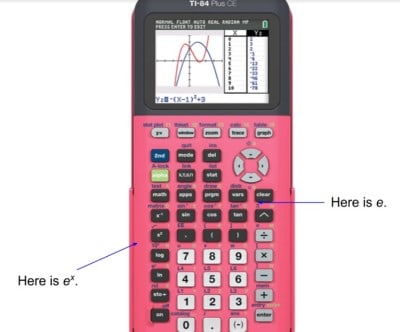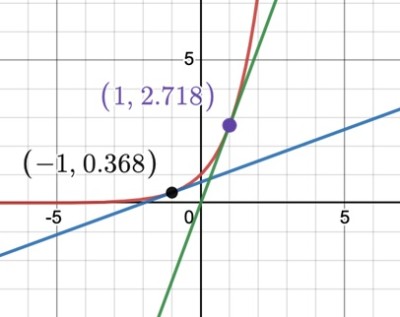What’s the deal with the number e? Do we really need another irrational number that has its own key on most calculators? Isn’t π enough?
Usually, the number e gets introduced to us when we first start learning about logarithmic and exponential functions. To high school students, the number e can seem like a mystery.
Having taught lots of high school students over the years, I often hear some version of this question, “What is e anyway?” In this article we’ll examine the fascinating history of the number e, explore various properties of e, and look at applications of e.
Let’s get started.
What is the number e?
Similar to π, e cannot be written as the ratio of two integers, so we say that e is irrational. In other words, e can’t be expressed as a fraction.
If we expand e to 1,000 or even 1,000,000 decimal places, we’d find that there is no repeating block of numbers. (Remember, repeating decimals are actually rational numbers.)
Here is the value of e to 15 decimal places:
- e ≈ 2.718281828459045…
Because e is irrational, if you write e as a decimal, it is an approximation and you no longer have an exact value. If you happen to own a TI-84, there are two places on the calculator where you can find e: above the ln key and above the division key.

Where did the number e come from?
First, the number e is called Euler’s number. But, interestingly, it was actually the 17th century mathematician Jacob Bernoulli who discovered e. How did he do this? It turns out, he was thinking about compound interest.
Bernouilli’s thoughts probably went something like this:
Suppose you invest $1 at 100% annual interest. If interest is compounded annually, at the end of the year, you would have $2.
Well, what if the bank is feeling generous and decides to still offer the 100% annual interest rate but compounds the interest semiannually instead? How much of a difference would that make in our savings account balance?
Since we’re compounding the interest twice per year, our growth factor will be 1 + ½, or 1.5.
Let’s take a look. In this case, we would have:
- At the end of 6 months: (1)(1.5) = $1.50
- At the end of 1 year: (1.50)(1.5) = $2.25
So, we’d end up with $2.25 at the end of the year instead of $2. In essence, our interest is earning interest so we end up with more at the end of the year. Woohoo!
What if the bank decides to compound the interest monthly? Then the interest gets compounded 12 times per year.
Would that make a huge difference in our savings? It seems as though compounding the interest more frequently would seriously increase the balance in our savings account, right?
What if the bank compounded the interest daily instead? Or hourly?
Let’s look at this more closely and crunch some numbers, as Bernoulli did a few centuries ago. We’ll use the formula for compounding interest:
- A(t) = P(1 + r/n)nt
where:
- A(t) = the amount after t years
- P = the principal (starting amount)
- r = the interest rate, expressed as a decimal
- t = time (in years)
- n = number of times per year that we compound the interest
Note, since the bank is using a rate of 100%, then r = 1. Our principal P is equal to $1 since that’s the amount of our initial investment. For all of our examples, the value of t will be 1 since we’re only interested in what happens after one year.
| Compounding frequency | A(t) = P(1 +r/n)nt | Balance |
| Annually (n = 1) | y = 1(1 +1/1)(1)(1) | $2.00 |
| Semi-annually (n = 2) | y = 1(1 +1/2)(2)(1) | $2.25 |
| Monthly (n = 12) | y = 1(1 +1/12)(12)(1) | $2.61… |
| Daily (n = 365) | y = 1(1 +1/365)(365)(1) | $2.71… |
| Hourly (n = 8,760) | y = 1(1 +1/8760)(8760)(1) | $2.718… |
compound interest with various compounding frequencies.
Notice that in our table, the limiting value of the balance in our savings account is approaching the value of e. Bernoulli figured out that there is actually a limiting value of our account balance, and that value is the number e!
In fact, if the bank had decided to compound interest continuously, we could use this formula:
- A(t) = Pert
where:
- A(t) = the amount after t years
- P = the principal (starting amount)
- r = the interest rate, expressed as a decimal
- t = time (in years)
Let’s look at a problem to see how this concept works in practice.
Example: Continuously Compounded Interest Using e
Suppose we invested $1,000 in a bank that paid 4% interest, compounded continuously. How much money would we have at the end of 3 years?
To solve this, we can use our formula:
- A(t) = Pert
Plug in the values P = 1,000, r = 0.04, and t = 3.
- A(t) = 1,000e(0.04)(3)
- A(t) = 1,127.496852
Rounding to the nearest penny, we would have $1,127.50 at the end of 3 years. Not bad.
The notion of continuous compounding is an important one in finance. Investors use the above equation to calculate the future value of an investment, based on the present value of the asset and the anticipated growth rate. While in practice, banks don’t compound interest continuously,
“the concept is crucial for understanding the behavior of many different types of financial instruments from bonds to derivatives contracts.”
-Will Kenton of Investopedia

A few decades after Bernoulli had this breakthrough about compound interest, Leonhard Euler, a Swiss mathematician, worked out more of the math and proved that e is irrational so e is often called Euler’s Number.
What is e used for in real life?
We find e in other areas of life as well. We’ve seen that finances can grow exponentially.
Besides investments, other things can grow or decay exponentially, perhaps not forever, but for a period of time. For example, populations can grow or decay exponentially according to the formula:
- P(t) = P0ekt
where
- APt) = the population after t years
- P0 = the original population when time t = 0
- k = the growth constant
- t = time
Let’s look at a population problem.
Example: Population Growth Using e
Suppose a certain furry creature on a distant planet increases 10-fold every 12 hours. If we start with 2 such creatures, how many will we have after 3 days?
Solution: In this situation, our original population P0 when time t = 0 is equal to 2. Since each creature increases by a factor of 10, after t = 12 hours, we have P(t) = 20.
To solve the problem, we need to determine the growth constant k, which we can do easily enough by plugging in our values.
- P(t) = P0ekt
- 20 = 2·e12k [Divide both sides by 2]
- 10 = e12k [Take natural log of both sides]
- ln(10) = ln(e12k) [Simplify]
- ln(10) = 12k [Divide both sides by k]
- k = ln(10)/12 ≈ 0.192
Now that we have our growth constant, k = 0.192, we can plug in our values to determine the population of the creatures after 3 days. Because 3 days is equal to 3·24 = 72 hours, t is equal to 72. So we have:
- P(t) = P0ekt
- P(t) = 2e(0.192)(72)
- P(t) ≈ 2,017,051
So, after 3 days, we’ll have about 2 million creatures! That’s kind of a lot. I hope they aren’t stuck in a confined space like a spaceship.
At this point, you may be wondering, “e probably comes up in probability too, right?” That’s correct! Well, if you like gambling, which I’m not recommending, the number e turns up in certain situations.
Suppose you are in Monte Carlo, playing the roulette wheel. If you bet on a single number, the chances of you winning on one spin is equal to 1/37. If you play the game 37 times, the probability of losing every time is approximately equal to the value 1/e.

What’s so special about the number e?
Besides the applications we’ve seen, e is used in calculus quite a bit. In fact, it has a unique property among functions. It turns out that the function y = ex is its own derivative! That’s right:
- d/dx (ex) = ex
What does this mean? In calculus terms, this means that at any point on the function y = ex, the slope of the tangent line at that point is also equal to ex!
In the graph below, the red curve is the function y = ex. At the point (1, e) the slope of the tangent line is equal to e. So, the green line is the graph of the tangent line at (1, e).
The point (-1, e-1) which is approximately (-1, 0.36) is also on the curve y = ex. The blue line is the graph of the tangent line at the point (-1, e-1).
Its slope is equal to e-1. If we could do this indefinitely, we’d find that the slopes of all of the tangent lines would be equal to ex. This is a very cool result!

Here is another fun fact involving e. Our friend Euler discovered an equation that uses e as well as some other familiar constants:
- eiπ+ 1 = 0
This equation is called Euler’s Identity and is considered to be one of the most beautiful math equations ever! Seriously!
Why is that? Because it relates some of the most important constants in math and ties them together in one equation. It relates the numbers 1, 0, e, π, and the imaginary number i, where i2= -1.
What is the definition of the number e?
As we saw from our example with compound interest, one definition of e is the limit:
- limn->∞ (1 + 1/n)n = e
This limit tends to come up in calculus courses. Its close cousin is another definition of e:
- limn->∞ (1 + n)1/n = e
Still another definition that is sometimes used for e involves an infinite sum. Euler himself discovered this sum that involves factorials. Remember, to calculate 4!, for example, we multiply 4·3·2·1 = 24.

Try this sum on your calculator but choose an upper limit equal to a relatively large number, like 50. If you choose a number that is too big, the calculator won’t support the large number. If the upper limit is n = 50, the value of the sum will equal e correct to several decimal places.
Another definition: e is the base of the natural logarithm function. This is perhaps when students first learn about the number e. So, when you work with the natural log function ln(x), it is equal to the function loge(x).
(You can learn more about logarithmic functions here).
Logarithms were invented by the Scottish mathematician John Napier in the early 17th century. While he didn’t discover the constant e, he laid some important groundwork in mathematics!
Conclusion
As we’ve seen, e isn’t just a number that teachers came up with to aggravate their students! Its history is pretty interesting, dating back a few centuries. And some celebrity status mathematicians all played a part in establishing e’s firm place as a giant among math constants. Move over π.
You can learn about how e is related to the rules of logarithms here.
I hope you found this article helpful. If so, please share it with someone who can use the information.
Don’t forget to subscribe to our YouTube channel & get updates on new math videos!
About the author:
Jean-Marie Gard is an independent math teacher and tutor. Based in Massachusetts, you can get in touch with Jean-Marie at https://testpreptoday.com/.


